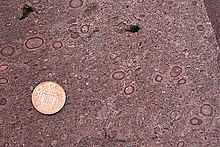Stoer Group
[2] Away from the unconformity the breccia becomes crudely stratified within an overall fining upwards sequence passing up into pebbly sandstones, the deposits of small alluvial fans.
The lower part of these sandstones are almost unbedded being replaced upwards by half metre thick beds capped by siltstones often with well-preserved desiccation structures.
The Bay of Stoer Formation consists of a lower section formed of red trough cross-bedded sandstones with some pebbles, interpreted to be the deposits of a braided river system.
The uppermost 100 m of the formation, the Stac Fada and Poll a' Mhuilt members, form a distinctive marker layer within the Stoer Group succession with a strike extent of 50 km.
The Stac Fada Member is generally about 10 m thick and consists of muddy sandstone facies with abundant clasts of vesicular volcanic glass, locally with accretionary lapilli.

